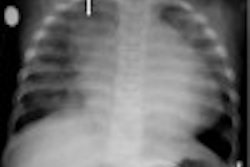
Researchers from Ohio were able to dramatically improve the clinical histories submitted with patient images by turning to radiologic technologists, who provided far more detailed -- and useful -- histories than referring physicians. The researchers believe the more complete histories will lead to better image interpretation.
The group from Cincinnati Children's Hospital conducted the project to improve the quality and consistency of clinical histories provided to radiologists for radiography exams acquired in the outpatient and emergency department settings. After implementing a protocol to improve histories, the number of radiography exams accompanied by a complete clinical history jumped from 38% to 95%, according to an article in the April issue of the American Journal of Roentgenology (April 2014, Vol. 202:4, pp.790-796).
"Inadequate patient histories have been a problem since the dawn of radiology," corresponding author Dr. David Larson, now at Stanford University, told AuntMinnie.com. "And if we don't know the clinical scenario, it makes providing referring physicians with an answer to a particular clinical question that much harder."
What, when, and where
Part of the problem is that imaging requests can be made without them being specific, said lead author Dr. Matthew Hawkins, who is now at Seattle Children's Hospital.
"If a patient comes into the ER and needs a foot x-ray, that test can be ordered and paid for with just 'pain' as the description," he told AuntMinnie.com. "But it's more helpful to know how long it's been since the injury was sustained and where it occurred."
 Dr. Matthew Hawkins of Seattle Children's Hospital.
Dr. Matthew Hawkins of Seattle Children's Hospital.Hawkins, Larson, and colleagues conducted a quality improvement initiative that included four phases: launch, support, transition to sustainability, and maintenance. The group decided that an adequate clinical history should contain three elements:
- The nature of the symptoms and a description of injury or the cause for clinical concern
- Duration of symptoms or time of injury
- Focal site of the patient's pain or abnormality
To simplify, they reduced the protocol to three elements: what, when, and where.
"Radiology department leaders established a goal that the history accompanying chest, abdomen, and extremity radiography performed in outpatient and emergency department settings should meet all three criteria in at least 95% of cases within 12 weeks of beginning the project," Hawkins and colleagues wrote. "To achieve this goal, technologists were expected to supplement the clinical history when that provided by the referring clinician did not already meet the criteria."
For the weeklong launch phase, the researchers met with department managers and technologists and shared an educational presentation describing the project and its purpose.
"We showed technologists examples of how more complete clinical histories helped us find things we would not have otherwise," Hawkins said.
 Dr. David Larson of Stanford University.
Dr. David Larson of Stanford University.The support phase lasted eight weeks and focused on teaching, coaching, and encouragement, as well as providing group-level feedback based on weekly audits. The team highlighted common reasons for incomplete histories and gave weekly progress reports to radiography managers, who then distributed them to technologists.
The project's "transition" phase concentrated on ongoing learning, group and individual feedback, and recognition of improvements. This phase lasted six weeks. Technologists received individual private weekly emails that contained all of the clinical histories they had provided during the previous week, which allowed them to compare their individual performance with group-level performance.
Finally, the initiative's maintenance phase focused on putting ongoing feedback and accountability structures in place. The group changed the audits from weekly to quarterly, and these results were incorporated into technologists' quarterly performance goals, which the technologists set, Larson said.
In all, 30,000 chest, abdomen, and extremity x-rays were performed in the emergency department and outpatient settings during the first three phases of the initiative. Of those, 3,400 were audited and the clinical histories analyzed.
The initial audit showed that 38% met the complete clinical history criteria. Twenty-two percent of these complete histories were based on data submitted by referring physicians, while technologists supplemented incomplete histories in another 21% of the cases. Examples of technologist-supplemented histories are shown in the table below.
| Clinical history, clinician vs. technologist | |
| History provided by referring clinician | History provided by technologist |
| Pain | Kicked bedpost 2 hours ago; pain in pinky toe |
| Pain | Injury to left foot 2 weeks ago; gymnastics twisting injury; pain along 5th metatarsal |
| Foot pain | Foot pain for 2 months; questionable overuse from dancing; pain between 1st and 2nd metatarsals |
| Thumb injury | Injured thumb while jumping on trampoline this evening; pain at interphalangeal joint |
Late in the support phase, when the researchers announced that technologists would receive confidential feedback on an individual basis in addition to group-level feedback, performance improved from 67% to 94% within three weeks.
"It was surprising how fast we saw improvement," Hawkins told AuntMinnie.com. "Most people want to help the team and [they] respond if you tell them specifically what needs to change."
The project's success was boosted by five factors:
- Establishing clear, quantifiable expectations
- Routine auditing
- Qualitative group and individual feedback
- Initial communication of expectations followed by coaching
- Gradual increase in individual accountability
Continued monitoring doesn't hurt, either, according to the authors.
"Performance has remained at or near the goal of 95% for seven months after the end of the improvement phase of the project," they wrote. "This is in contrast to [other studies] that found improvement in clinical history provided by referring physicians reverted to baseline performance within three months after the intervention. We believe our results are due at least in part to the continued auditing and accountability mechanisms established by the department."



















